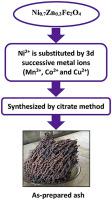当前位置:
X-MOL 学术
›
J. Phys. Chem. Solids
›
论文详情
Our official English website, www.x-mol.net, welcomes your
feedback! (Note: you will need to create a separate account there.)
Synthesis, structural characterization, and magnetic properties of Ni–Zn nanoferrites substituted with different metal ions (Mn2+, Co2+, and Cu2+)
Journal of Physics and Chemistry of Solids ( IF 4.3 ) Pub Date : 2020-11-01 , DOI: 10.1016/j.jpcs.2020.109620 N.I. Abu-Elsaad , A.S. Nawara , S.A. Mazen
Journal of Physics and Chemistry of Solids ( IF 4.3 ) Pub Date : 2020-11-01 , DOI: 10.1016/j.jpcs.2020.109620 N.I. Abu-Elsaad , A.S. Nawara , S.A. Mazen

|
Abstract Three series of nanocrystalline Ni0.7-xZn0.3MxFe2O4 ferrites (M = Mn2+, Co2+, and Cu2+; x = 0.0, 0.1, 0.3, 0.5, and 0.7) have been synthesized using the citrate method. Several techniques have been used to investigate the influence of the different dopant ions and their doping levels on the structural and magnetic properties of the Ni–Zn ferrites. X-ray diffraction (XRD) analysis confirmed the creation of a single-phase spinel structure. The lattice parameter was found to increase with increasing Mn2+ and Co2+ ion concentrations, but was not altered by adding Cu2+. The density decreased with increasing concentrations of Mn2+ or Co2+, but increased with increasing Cu2+ content. The average particle size estimated from transmission electron microscopy (TEM) images was found to be in the range 21–41 nm, which revealed the manufacture of nanocrystalline ferrites. Two prominent fundamental absorption bands detected in IR spectra between 370 and 570 cm−1 can be ascribed to the intrinsic stretching vibrations of tetrahedral and octahedral complexes. The magnetic properties of the present spinel ferrites were measured by means of a vibrating sample magnetometer (VSM) at room temperature. The measurements showed that the saturation magnetization (Ms) for Ni–Zn–Mn ferrite increased from x = 0.0 to x = 0.3, but then decreased upon doping at x = 0.7, whereas a monotonic increase in saturation magnetization was observed for Ni–Zn–Co ferrite. For Ni–Zn–Cu ferrite, Ms decreased from 54.70 emu/g at x = 0.0–35.4 emu/g at x = 0.1 and then increased with further addition of Cu2+. The variation of Ms with different dopant concentrations can be explained on the basis of Neel's two-sublattice model. Among the investigated series, Ni0.7-xZn0.3CoxFe2O4 nanoferrites achieved high saturation magnetization and coercive field values, indicating that such compositions may find applications in the field of sensors.
中文翻译:

用不同金属离子(Mn2+、Co2+ 和 Cu2+)取代的 Ni-Zn 纳米铁氧体的合成、结构表征和磁性能
摘要 采用柠檬酸盐法合成了三个系列的纳米晶 Ni0.7-xZn0.3MxFe2O4 铁氧体(M = Mn2+、Co2+ 和 Cu2+;x = 0.0、0.1、0.3、0.5 和 0.7)。已使用多种技术来研究不同掺杂离子及其掺杂水平对 Ni-Zn 铁氧体结构和磁性能的影响。X 射线衍射 (XRD) 分析证实了单相尖晶石结构的产生。发现晶格参数随着 Mn2+ 和 Co2+ 离子浓度的增加而增加,但不会因添加 Cu2+ 而改变。密度随着Mn2+或Co2+浓度的增加而降低,但随着Cu2+含量的增加而增加。发现从透射电子显微镜 (TEM) 图像估计的平均粒径在 21-41 nm 范围内,这揭示了纳米晶铁氧体的制造。在 370 和 570 cm-1 之间的红外光谱中检测到的两个突出的基本吸收带可以归因于四面体和八面体配合物的固有伸缩振动。本发明的尖晶石铁氧体的磁性能在室温下通过振动样品磁强计(VSM)测量。测量结果表明,Ni-Zn-Mn 铁氧体的饱和磁化强度 (Ms) 从 x = 0.0 增加到 x = 0.3,但在 x = 0.7 掺杂后降低,而观察到 Ni-Zn 的饱和磁化强度单调增加–钴铁氧体。对于 Ni-Zn-Cu 铁氧体,Ms 从 x = 0.0 时的 54.70 emu/g 下降至 x = 0.1 时的 35.4 emu/g,然后随着进一步添加 Cu2+ 而增加。根据 Neel 的二亚晶格模型,可以解释不同掺杂浓度下 Ms 的变化。在所研究的系列中,Ni0.7-xZn0.3CoxFe2O4 纳米铁氧体实现了高饱和磁化强度和矫顽场值,表明此类组合物可能会在传感器领域得到应用。
更新日期:2020-11-01
中文翻译:

用不同金属离子(Mn2+、Co2+ 和 Cu2+)取代的 Ni-Zn 纳米铁氧体的合成、结构表征和磁性能
摘要 采用柠檬酸盐法合成了三个系列的纳米晶 Ni0.7-xZn0.3MxFe2O4 铁氧体(M = Mn2+、Co2+ 和 Cu2+;x = 0.0、0.1、0.3、0.5 和 0.7)。已使用多种技术来研究不同掺杂离子及其掺杂水平对 Ni-Zn 铁氧体结构和磁性能的影响。X 射线衍射 (XRD) 分析证实了单相尖晶石结构的产生。发现晶格参数随着 Mn2+ 和 Co2+ 离子浓度的增加而增加,但不会因添加 Cu2+ 而改变。密度随着Mn2+或Co2+浓度的增加而降低,但随着Cu2+含量的增加而增加。发现从透射电子显微镜 (TEM) 图像估计的平均粒径在 21-41 nm 范围内,这揭示了纳米晶铁氧体的制造。在 370 和 570 cm-1 之间的红外光谱中检测到的两个突出的基本吸收带可以归因于四面体和八面体配合物的固有伸缩振动。本发明的尖晶石铁氧体的磁性能在室温下通过振动样品磁强计(VSM)测量。测量结果表明,Ni-Zn-Mn 铁氧体的饱和磁化强度 (Ms) 从 x = 0.0 增加到 x = 0.3,但在 x = 0.7 掺杂后降低,而观察到 Ni-Zn 的饱和磁化强度单调增加–钴铁氧体。对于 Ni-Zn-Cu 铁氧体,Ms 从 x = 0.0 时的 54.70 emu/g 下降至 x = 0.1 时的 35.4 emu/g,然后随着进一步添加 Cu2+ 而增加。根据 Neel 的二亚晶格模型,可以解释不同掺杂浓度下 Ms 的变化。在所研究的系列中,Ni0.7-xZn0.3CoxFe2O4 纳米铁氧体实现了高饱和磁化强度和矫顽场值,表明此类组合物可能会在传感器领域得到应用。










































 京公网安备 11010802027423号
京公网安备 11010802027423号